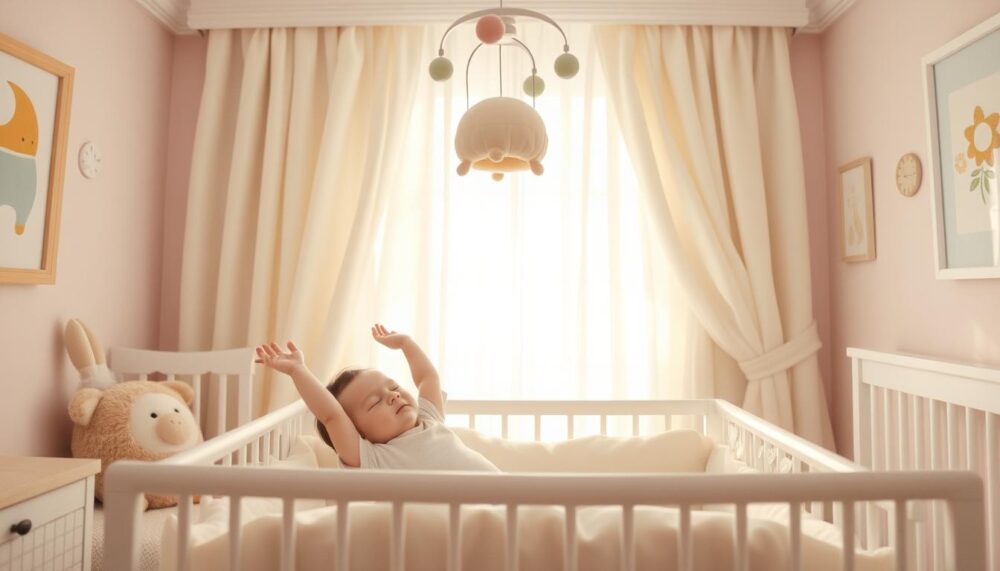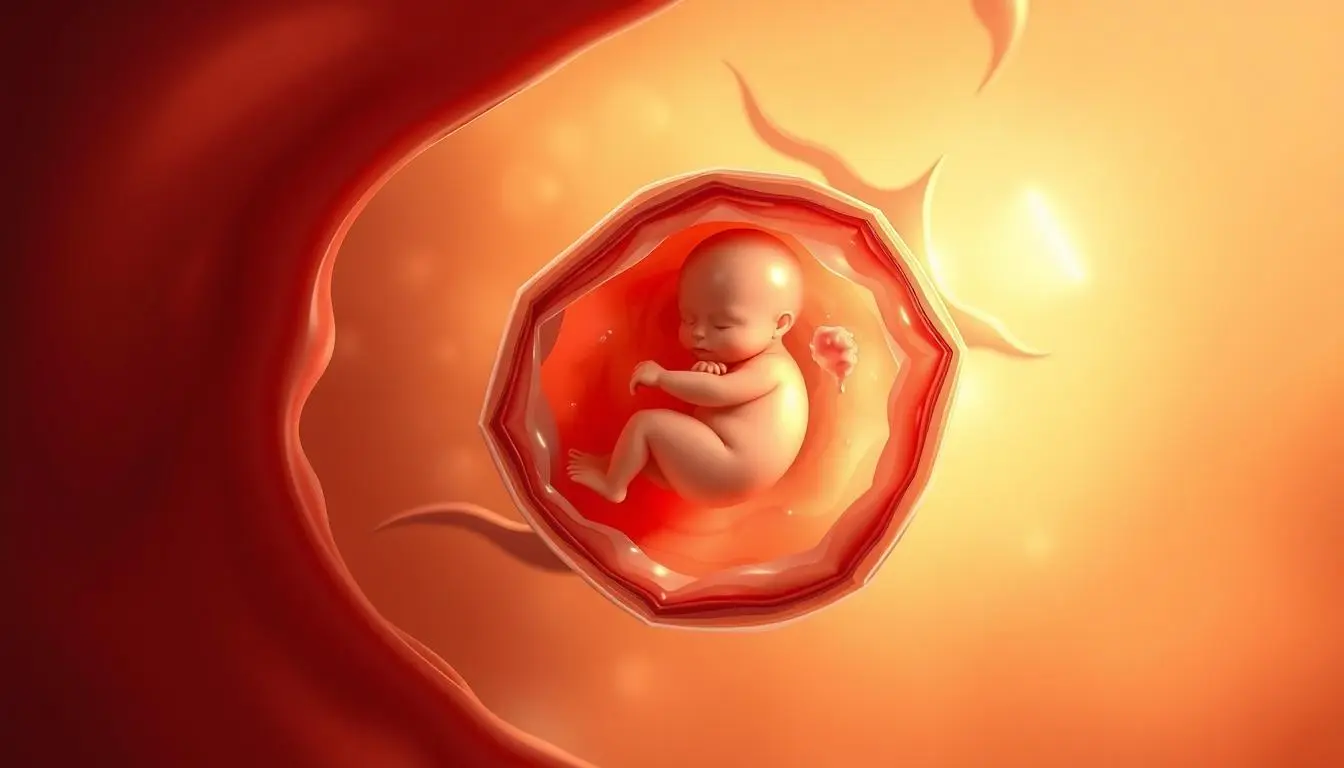As parents, we often find ourselves fascinated by our little ones’ quirks, including how they sleep. Have you ever noticed your baby sleeping with their arms raised up, almost as if they’re reaching for the stars? This sleep position has sparked many questions, including: Why do babies sleep with their arms up?
In this article, we’ll explore the science behind how babies sleep. We’ll look at developmental milestones, natural reflexes, and brain activity that lead to this unique sleeping habit. By understanding why babies sleep this way, we can better care for them during this important stage of their growth.
Key Takeaways
- Babies often sleep with their arms raised up due to a natural reflex called the Moro reflex, which is a startle response triggered by sudden movements or loud noises.
- The Moro reflex typically appears in newborns and gradually fades as they reach 4-6 months of age.
- Understanding the Moro reflex and its impact on infant sleep positions can help parents create a more soothing and comfortable sleep environment for their little ones.
- Monitoring changes in sleep positions as the baby grows can provide valuable insights into their development and help identify any potential concerns.
- Establishing a consistent sleep routine and creating a safe, comfortable sleep environment are essential for promoting healthy sleep habits in babies.
The Science Behind Baby Sleep Positions
Infant sleep positions are not just about comfort. They are deeply connected to human development. Many factors, like natural reflexes and brain activity, affect how a baby sleeps. This includes why they might lift their arms up while sleeping.
Developmental Milestones and Sleep Patterns
Babies’ sleep patterns change as they grow. Newborns spend a lot of time sleeping, often curled up with arms raised. This helps with their motor skills and muscle control, which are still developing.
Natural Reflexes in Newborns
Babies lift their arms up while sleeping due to the Moro reflex. This is a natural startle response present from birth. It makes a baby extend their arms and legs, sometimes with a loud cry, in response to sudden movements or noises. As a baby grows, this reflex fades, leading to more stable sleep.
Brain Development During Sleep
Sleep is vital for a baby’s brain development. The position they sleep in can affect this. For example, the arms-up position may help with blood flow and oxygen to the brain. This is important for brain maturation and cognitive function.
Knowing the science behind infant sleep positions helps parents understand their baby’s sleep habits. It also supports healthy development.
Why Do Babies Sleep with Their Arms Up?
Have you ever seen your baby sleeping with their arms up near their head? This is a common sight for new parents. But it’s actually very important for your baby’s growth and comfort. Let’s explore why babies sleep with their arms up.
The Moro reflex is a big reason. It’s a natural startle response that makes babies throw their arms out and then pull them back in. This reflex helps them keep warm and feel safe as they sleep.
Also, keeping their arms up helps babies keep their spine straight. This is good for their muscle growth and comfort. It also lets them breathe better while they sleep.
“Babies often sleep with their arms up because it helps them feel safe, cozy, and supported as they rest.”
When your baby sleeps with their arms up, it means they’re in a deep sleep. As they move from lighter sleep stages, their muscles relax. This lets their arms naturally go up.
So, if you see your baby sleeping with their arms up, it’s a good sign. It shows they’re growing well and sleeping soundly. Enjoy this sweet sight of your baby sleeping peacefully.

The Moro Reflex: Understanding Startle Response
Newborns start to explore the world, and their sleep patterns show a unique phenomenon called the Moro reflex. This response happens when a baby feels a sudden change in balance or support. It’s closely linked to the arms-up sleep position many infants naturally choose.
When Does Moro Reflex Begin?
The Moro reflex starts within the first few weeks of a baby’s life. It’s a natural part of their development. This reflex helps infants react to threats, preparing them to seek safety and comfort.
How Long Does It Last?
The Moro reflex fades as a baby grows and develops. It usually disappears by 4 to 6 months of age. This shows the infant’s brain and nervous system are maturing, helping them better handle external stimuli.
Managing the Startle Reflex
While the Moro reflex is normal, parents can soothe and manage it. Gentle swaddling, rocking, or a secure sleep environment can help. These actions can reduce the impact of the Moro reflex and ensure your baby sleeps well.
Understanding the Moro reflex and its link to the arms-up sleep position helps parents support their baby’s sleep. It promotes healthy growth and development.

Benefits of Arms-Up Sleep Position
The arms-up sleep position is good for babies. It helps them sleep better, self-soothe, and even grow better. This natural way of sleeping is common in newborns.
One key benefit is better sleep quality. Babies with their arms up sleep deeper and wake up less. This is great for their brain and body growth in the early years.
Also, the arms-up position helps with self-soothing. Babies can easily find their fingers or thumb. This helps them calm down and sleep better at night. It also means parents get more rest too.
“The arms-up sleep position allows babies to easily access their hands, which can provide a natural pacifier and promote self-soothing during sleep.”
Studies also show it might help with developmental benefits. It matches how babies naturally move their arms. This could help their muscles and brain work better.
Even though it’s safe, parents should still follow safe sleep rules. This includes putting babies on their backs and keeping the sleep area clear of dangers.

Knowing about the arms-up sleep position helps parents support their baby’s sleep and growth. It answers the question why do babies sleep better in your arms? and helps them thrive.
Common Sleep Positions in Different Age Groups
Babies change how they sleep as they grow. Knowing the common sleep positions at each stage helps parents create a safe and cozy sleep space for their babies.
Newborn Sleep Positions
Newborns usually sleep with their arms up, like a starfish. This is because of the Moro reflex, which makes them move their arms suddenly. They also sleep on their backs, which is safest to prevent Sudden Infant Death Syndrome (SIDS).
Infant Sleep Transitions
As babies get older, they might start sleeping in different ways. Some might roll onto their sides or stomachs. Others might bring their arms closer to their bodies. These changes are part of growing up, but it’s key to keep their sleep area safe and supportive.
Safe Sleep Guidelines
- Always place babies on their backs to sleep, even for naps.
- Avoid soft bedding, such as pillows, blankets, or bumper pads, in the crib.
- Use a firm, flat mattress and a well-fitting sheet.
- Keep the sleeping area free of any loose objects or toys.
- Consider using a pacifier to help reduce the risk of SIDS.
By following these safe sleep guidelines and knowing the common sleep positions at different ages, parents can ensure their baby’s comfort and safety during this important time.

When Should Parents Be Concerned?
It’s key for parents to know when a baby’s arm position is normal and when it’s not. Most of the time, babies lifting their arms up while sleeping is just a natural reflex. But, there are times when parents should pay closer attention.
Watch if the baby’s arms seem stiff or rigid instead of relaxed. This could mean the Moro reflex is still active longer than usual. Also, if the baby has trouble moving their arms or looks uncomfortable, it’s best to talk to a pediatrician.
Another thing to watch is if the baby’s sleep is getting worse. This includes waking up a lot or having trouble falling asleep. While some babies sleep with their arms up, too much restlessness or trouble sleeping might mean there’s a problem.
It’s also important to think about the baby’s health and growth. If the baby is having trouble eating, not gaining weight, or missing important milestones, it’s time to talk to a doctor.
By paying close attention to their baby’s behavior and acting quickly on any concerns, parents can help their baby sleep well and grow strong.
| Potential Concern | What to Look For | When to Seek Medical Attention |
|---|---|---|
| Persistent Moro Reflex | Stiff or rigid arm movements | If the reflex persists beyond the typical timeframe |
| Disrupted Sleep Patterns | Frequent waking, difficulty settling | If the baby is experiencing significant sleep disruptions |
| Developmental Concerns | Feeding difficulties, poor weight gain, missed milestones | If the arm-up sleeping is accompanied by other concerning symptoms |
By being alert and addressing any issues early, parents can keep their baby safe and healthy during this critical time.

Creating the Perfect Sleep Environment
It’s important to make sure your baby’s sleep area is cozy and safe. This includes controlling the temperature and using the right swaddling techniques. Let’s look at how to set up the best sleep space for your baby.
Temperature and Comfort
The room temperature should be between 68°F and 72°F (20°C and 22°C) for your baby’s sleep. Dress them in light, breathable clothes. Use a light blanket or sleep sack to keep them comfortable without getting too hot or cold.
Watch for signs like sweating or shivering. If you see these, adjust the temperature to keep your baby comfortable.
Swaddling Techniques
Swaddling can make your baby feel secure and comfortable, especially if they sleep with their arms up. It can also help prevent the startle reflex and improve sleep quality. But, it’s important to swaddle safely to avoid hip dysplasia or overheating.
Stop swaddling when your baby starts trying to roll over. This is a sign they’re getting too big for it.
Sleep Surface Safety
The sleep surface, like a crib or bassinet, must be firm and free of loose bedding or toys. Make sure the mattress fits the sleep space well. Use a sheet that fits tightly to keep your baby safe and comfortable.
| Recommendation | Description |
|---|---|
| Firm Mattress | Use a firm, flat mattress that conforms to safety standards. |
| Tight-Fitting Sheet | Ensure the sheet fits the mattress snugly, with no loose fabric. |
| No Soft Objects | Remove any pillows, blankets, toys, or other soft items from the sleep area. |
By making your baby’s sleep area comfortable, safe, and the right temperature, they can sleep well. This is true even if they like to sleep with their arms up.
Tips for Better Baby Sleep Habits
Getting your baby to sleep better can change your whole family’s life. A few easy steps can help your baby sleep well at night. Why do babies sleep better in your arms? Let’s look at some tips that really work.
Establish a Consistent Bedtime Routine
Babies love routine. A bedtime routine tells them it’s time to sleep. Try a warm bath, a gentle massage, or a favorite story to help them relax.
Create a Calming Sleep Environment
Make your baby’s room cool, dark, and quiet. Use white noise or soft music to block out loud sounds. Stay away from bright lights and screens before bed to help them sleep better.
Practice Gentle Sleep Training
If your baby has trouble sleeping alone, try gentle sleep training. Methods like the Ferber method or pick-up/put-down can help. They teach your baby to sleep on their own, leading to better sleep.
Respond to Your Baby’s Cues
Watch for signs your baby is tired, like yawning or rubbing their eyes. Put them down for a nap or bedtime right away. Being overtired makes it hard for them to fall and stay asleep.
By following these tips, you can help your baby sleep better in your arms. This will make sleep better for everyone in your family.
Conclusion
Babies sleep with their arms up because of the Moro reflex. This natural reflex makes them extend their arms when they feel a sudden change. As they grow, this reflex fades, and their sleep positions change.
We’ve looked into why babies sleep in certain ways and how it’s good for them. The Moro reflex is a normal part of growing up. It’s not something to worry about.
Every baby is different, and their sleep habits can change. Knowing why they sleep in certain ways helps you support their health. This knowledge helps in teaching them good sleep habits as they grow.
FAQ
Why do babies lift their arms up while sleeping?
Babies lift their arms up because of the Moro reflex. This reflex makes them startle and throw their arms up when they hear loud noises or feel sudden movements. It’s a natural part of their growth and helps them feel safe and comforted.
Why does my baby keep putting her arms up?
Babies lift their arms for a few reasons. The Moro reflex is one, and it makes them startle and raise their arms. They also do it to stay cool and relax their muscles while sleeping.
When do babies sleep with arms up?
Newborns and young babies often sleep with their arms up. This is because the Moro reflex is strongest in the early months. By 4-6 months, this reflex starts to fade, but some babies still find it comfortable to sleep this way.
Why do babies sleep better in your arms?
Babies sleep better in your arms because it feels comforting and secure. Being held reminds them of the womb, making them feel safe and calm. The motion and warmth also help them sleep deeper and more restfully.
Why do babies sleep with their arms above their head?
Babies sleep with their arms above their head for a few reasons. It helps them stay cool by letting heat escape. It also lets their muscles relax fully, leading to better sleep. The Moro reflex also plays a part, causing them to raise their arms during sleep.
read Also : How Long Do Babies Sleep in Bassinet: Age Guide














